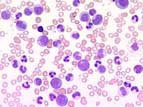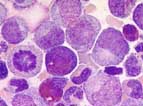Chronic myelocytic leukemia
Abstract:
CML most often occurs in older adults (median age around 50). It belongs to the group of myeloproliferative syndromes. The process is characterized by a long chronic stage which then evolves into an accelerated phase and ends with the terminal blastic phase. As in CLL, CML is often discovered in the blood film by chance. In over 90% of the cases a chromosomal translocation (9;22) is found. This cytogenetic abnormality is also known as the Philadelphia chromosome. At the molecular level, the corresponding fusion transcript BCR-ABL is found.
Clinical picture:
Symptoms of CML are fatigue, night sweats, loss of weight and abdominal discomfort due to splenomegaly. Occasionally, bruises also occur. The duration of the chronic phase is about 3.5 years, on average, but can vary from 1 to 10 years. After the accelerated phase begins, a few months to a year normally pass before the blast phase begins. This corresponds to the picture of an acute leukemia and is usually therapy-resistant. About one-third of these are of lymphoblastic nature. In the chronic stage, two good therapeutic options exist. First-line therapy is alpha interferon and second-line therapy is hydroxyurea. Allogenic stem cell transplantation is so far the only long-terme cure for CML. With the selective BCR-ABL tyrosine kinase inhibitor STI571 (Gleevec/Glivec), there is a new promising drug available for the treatment of CML .
 Hematology:
Hematology:
CML often has very high leukocyte counts with values up to 300 x109/ L. In peripheral blood, all stages of granulopoiesis are represented. Eosinophils and basophils are also typically increased. Thrombocytosis is frequent. Anemia usually first develops with very high leukocyte counts. The leukocyte alkaline phosphatase score in peripheral blood is very low or absent.
 Bone marrow
Bone marrow
The bone marrow is hypercellular with a clear dominance of granulopoiesis. The number of megakaryocytes is also increased. The same is true for basophils and eosinophils. Sea-blue histiocytes can occur in CML, but they are also observed in other diseases.
Table of Contents
 Hematology:
Hematology: Bone marrow
Bone marrow